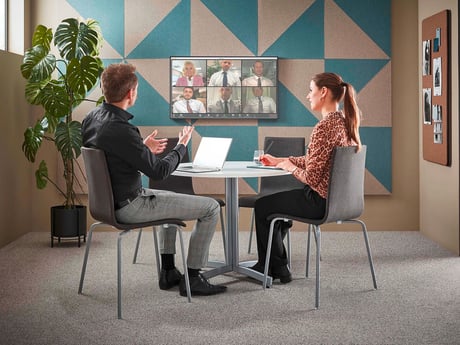- AJ Products UK
- Blog: Tips to Inspire Happiness at Work
- Tips & trends
- Hybrid working: how to balance office-based working and work from home

Hybrid working: how to balance office-based working and work from home
The workplace is changing and businesses must adapt to ensure they can support their employees wherever they work.
Previously in our Return to Work series, we discussed how to adapt your office space to suit post-pandemic working patterns given that many employees will likely do a mixture of office-based and remote working in future. Today, we look in closer detail at how to implement and support a hybrid working model. It will be easy for businesses to decide that they want employees to work some days a week in the office and some days at home but much harder to provide the correct support to protect employee wellbeing, productivity and mental health under this new model. We will look at what structures can be put into place to ensure a smooth transition, what changes need to be made to the way the company works and how to support staff on work from home days.
How to implement hybrid working
A clear policy
Companies should set expectations and have a clear policy for hybrid working. Does it mean three days in the office and two at home or 4 to 1? Are staff expected in on particular days or do they have total flexibility? Equally, do staff have control over their working hours or are they expected to be available at set times? It is important to take a decision and communicate it clearly at all levels of the company. To ensure the policy is successful, businesses should involve employees throughout the decision-making process.
The goal with hybrid working is to ensure that all members of staff are equally productive in the office and at home and that there is no disruption to the team regardless of where people are working. One strategy might be to co-ordinate team schedules in order to have specific days for in-person meetings and collaborative activities, such as project kick-offs, pitch meetings and brainstorming sessions. Individual tasks can then be allocated to remote working days where they are fewer disruptions.
The goal with hybrid working is to ensure that all members of staff are equally productive in the office and at home and that there is no disruption to the team regardless of where people are working. One strategy might be to co-ordinate team schedules in order to have specific days for in-person meetings and collaborative activities, such as project kick-offs, pitch meetings and brainstorming sessions. Individual tasks can then be allocated to remote working days where they are fewer disruptions.
Technology is key
The rise of remote working, whether part or full time, means that the right technological solutions are essential. At a basic level, this means ensuring every employee has all the right equipment to work effectively in any location. But it also means investing in the right software to provide effective communications tools, video conferencing and project management tools so that colleagues can work together in real time, as well as advanced cybersecurity. You can also support agile working by implementing a desk and meeting room booking system that allows staff to book workspace via a mobile app for example.
Built on trust
It is important to change the way the company thinks about remote work. Many businesses have previously taken a negative view of working from home, but the pandemic has shown that workers can be just as productive out of the office. For hybrid working to be successful, manager-employee relationships must be built on trust with the focus placed more on business outcomes than hours worked. Companies cannot just pay lip service to the idea of flexibility it must be backed with real change, which means allowing staff to set their working hours, choose the location they work the best and not favouring staff who work more frequently in the office. One of the easiest mistakes to make is overlooking people because they are not in the physical office when meetings take place or key decisions are made. Businesses need to be aware of this potential bias and work actively to avoid it by providing additional training for managers centred around how to manage a remote team.
Supporting remote workers
Managers must take the time to connect with their team on remote working days with a particular eye on mental health. It is important to reach out to people both individually (so they can discuss personal issues or concerns about their work) and as a team. This should be supported with regular in-person meetings as well. It’s important to understand individual needs and personal situations that may require the employer to be more flexible. Creating an open culture is a key driver of success when it comes to successful agile working.
Adapt the workplace
To support the change in working practices, companies should optimise their physical office space to prioritise collaboration and human connection with more meeting spaces and breakout areas. Businesses should also help workers to create an ergonomic home office space where they can be both comfortable and productive while working remotely.
By re-examining the physical workspace, IT infrastructure and the challenges faced by employees, businesses can implement a successful hybrid working policy that benefits the company and its staff alike. As part of our Return to Work series, AJ Products has shared advice on how to ensure the workplace is safe for employees to return and how to support employee mental health. Over the coming weeks, we will also discuss how to implement an employee wellbeing programme and other tips on how to optimise the workspace post pandemic.
By re-examining the physical workspace, IT infrastructure and the challenges faced by employees, businesses can implement a successful hybrid working policy that benefits the company and its staff alike. As part of our Return to Work series, AJ Products has shared advice on how to ensure the workplace is safe for employees to return and how to support employee mental health. Over the coming weeks, we will also discuss how to implement an employee wellbeing programme and other tips on how to optimise the workspace post pandemic.
Dos and don’ts of hybrid working
Do:
- Set a clear policy about hybrid/remote working.
- Offer flexibility over working hours and location.
- Promote trust and openness between employees and management.
- Invest in technology to improve communication, collaboration and cybersecurity.
- Adapt the office space to suit new ways of working.
- Prioritise employee wellbeing.
Don’t:
- Favour those who spend more time in the office.
- Assume the office is where employees are most productive.
- Enforce rigid working hours.
- Promote a one-size-fits-all approach.
Get the latest product launches and offers sent direct to your inbox
Do you want to receive exclusive offers, information about new products and inspiration on how you can improve your workplace? Sign up for our free newsletter and be the first to receive our best offers!Please wait...
*By clicking subscribe, I confirm that I have read the privacy policy.



